
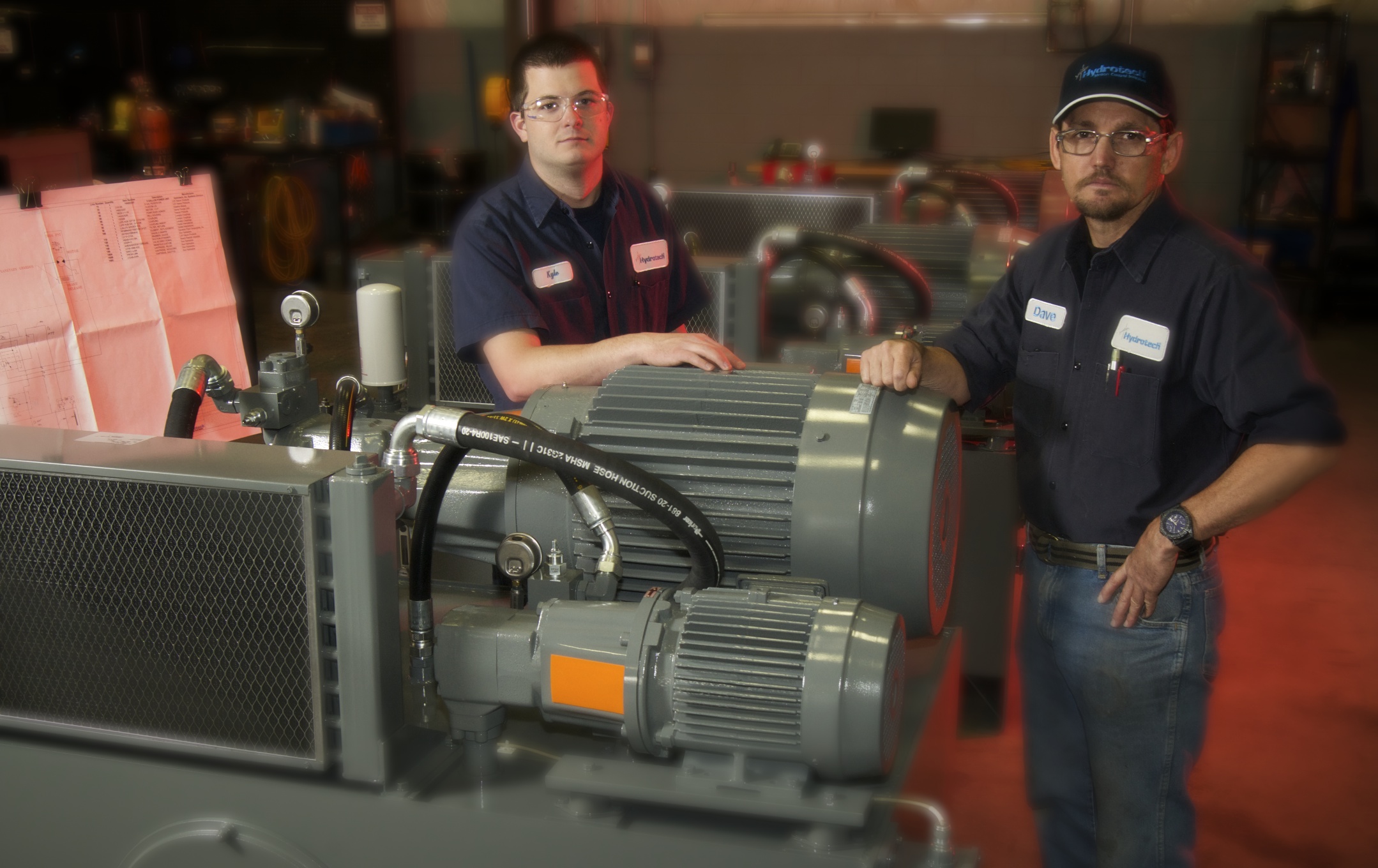
Designing the right hydraulic power unit may involve complex technology, but it doesn't need to be a complex process. Our team of engineers keep it simple while providing a modern, efficient solution packed with the latest technology. This case study is brought to you in strategic partnership with Bosch Rexroth.
1. Overall Power and Force Requirements
Power units are primarily the functional drive unit for a hydraulic application. To be successful in designing or sizing a power unit, the designer must know what will be driven, and in what sequence. Additionally, the size, the number of actuators, volumes and the distance of piping runs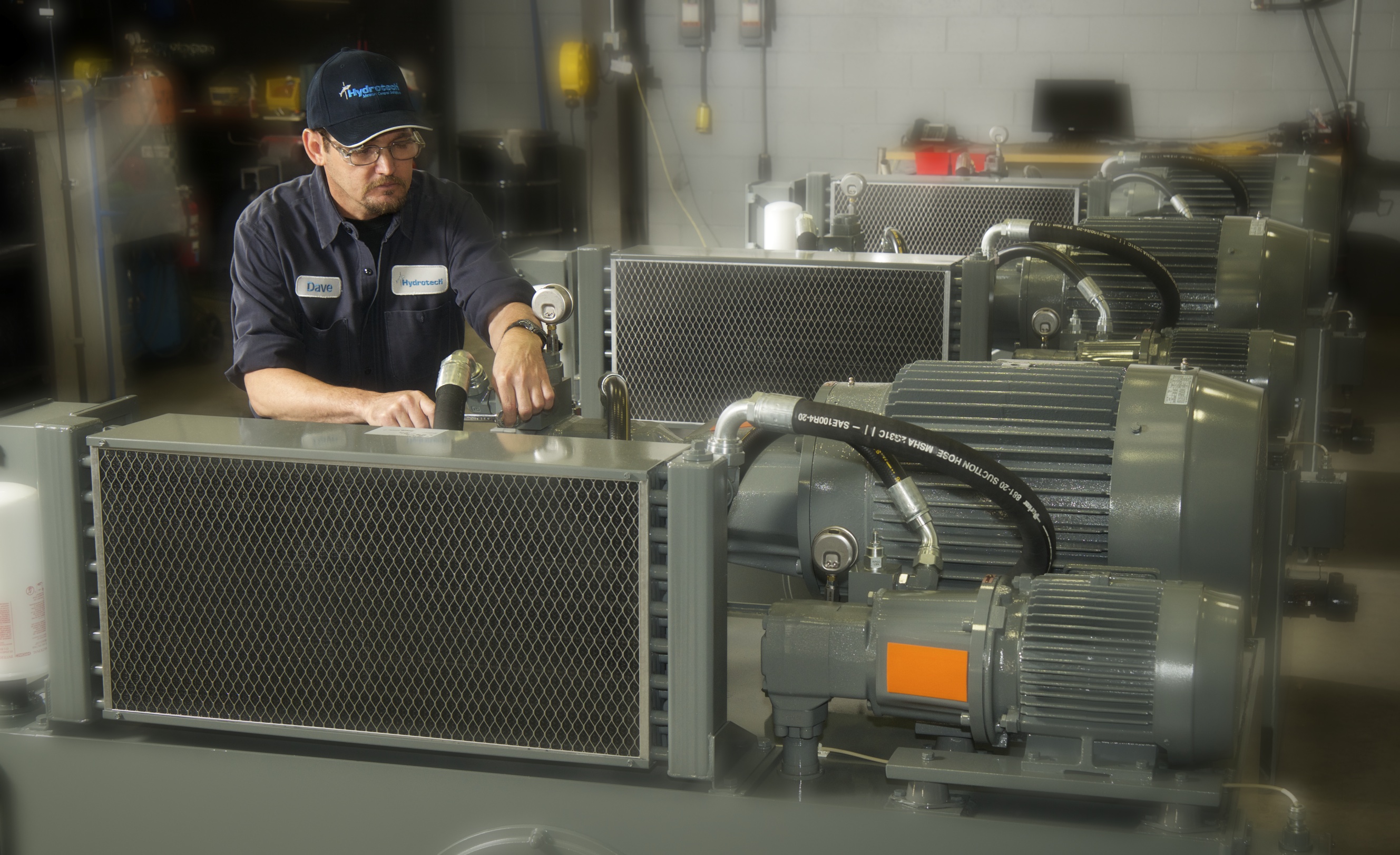 must be considered, as all these factors will affect the capacity, power and force requirements. This will also help determine whether the resultant power unit can be achieved using a configurable, or pre-engineered unit, or will instead require a unique, custom build. Pre-engineered units will vary from manufacturer to manufacturer; however, drive requirements in excess of 100 HP are often beyond the scope of configurable units. Power units used for serial design, i.e. those built to a custom specification for a particular machine type, model or frame size, may be possible to achieve using a configurator or pre-engineered unit. Flow rates will also have an impact on the design of the power unit. While formulae may provide guidelines with respect to reservoir size and installed pump capacity, the designer need also consider return flows, or decompression rates / flows being returned to the reservoir. High rate or peak flow occurrences, for example accumulator discharges, need to be considered in both the construction, sizing, breathing and conditioning of the reservoir.
must be considered, as all these factors will affect the capacity, power and force requirements. This will also help determine whether the resultant power unit can be achieved using a configurable, or pre-engineered unit, or will instead require a unique, custom build. Pre-engineered units will vary from manufacturer to manufacturer; however, drive requirements in excess of 100 HP are often beyond the scope of configurable units. Power units used for serial design, i.e. those built to a custom specification for a particular machine type, model or frame size, may be possible to achieve using a configurator or pre-engineered unit. Flow rates will also have an impact on the design of the power unit. While formulae may provide guidelines with respect to reservoir size and installed pump capacity, the designer need also consider return flows, or decompression rates / flows being returned to the reservoir. High rate or peak flow occurrences, for example accumulator discharges, need to be considered in both the construction, sizing, breathing and conditioning of the reservoir.
2. The Operating Environment and Location
In creating the specification for a power unit, the basic considerations may seem straightforward: type, number and size of actuators, line size(s), flow rates, pressure(s) expected, filtration, settling time, internal reservoir design (e.g.: baffling) and noise (both structural and air-borne). All of these factors influence the sizing and selection of a power unit and whether it’s possible to use a standard or a pre-engineered solution. Consumption of plant-floor real estate, whether the power unit is integral to the machine base or not, considerations for ancillary support services such as power, water, air and other necessary utilities are additional basic factors that a power unit designer must consider beyond just the specifications of individual components. But the physical location and operating environment can provide a surprising number of additional parameters to consider. Ambient temperature, operating conditions, elevation and many other environmental criteria may need to be thought about or addressed in the specification of a power unit. A power unit destined for high elevations will need to consider suction / inlet conditions much more stringently than the same unit at sea-level. Shipboard or salt-spray environment? You may need specific marine 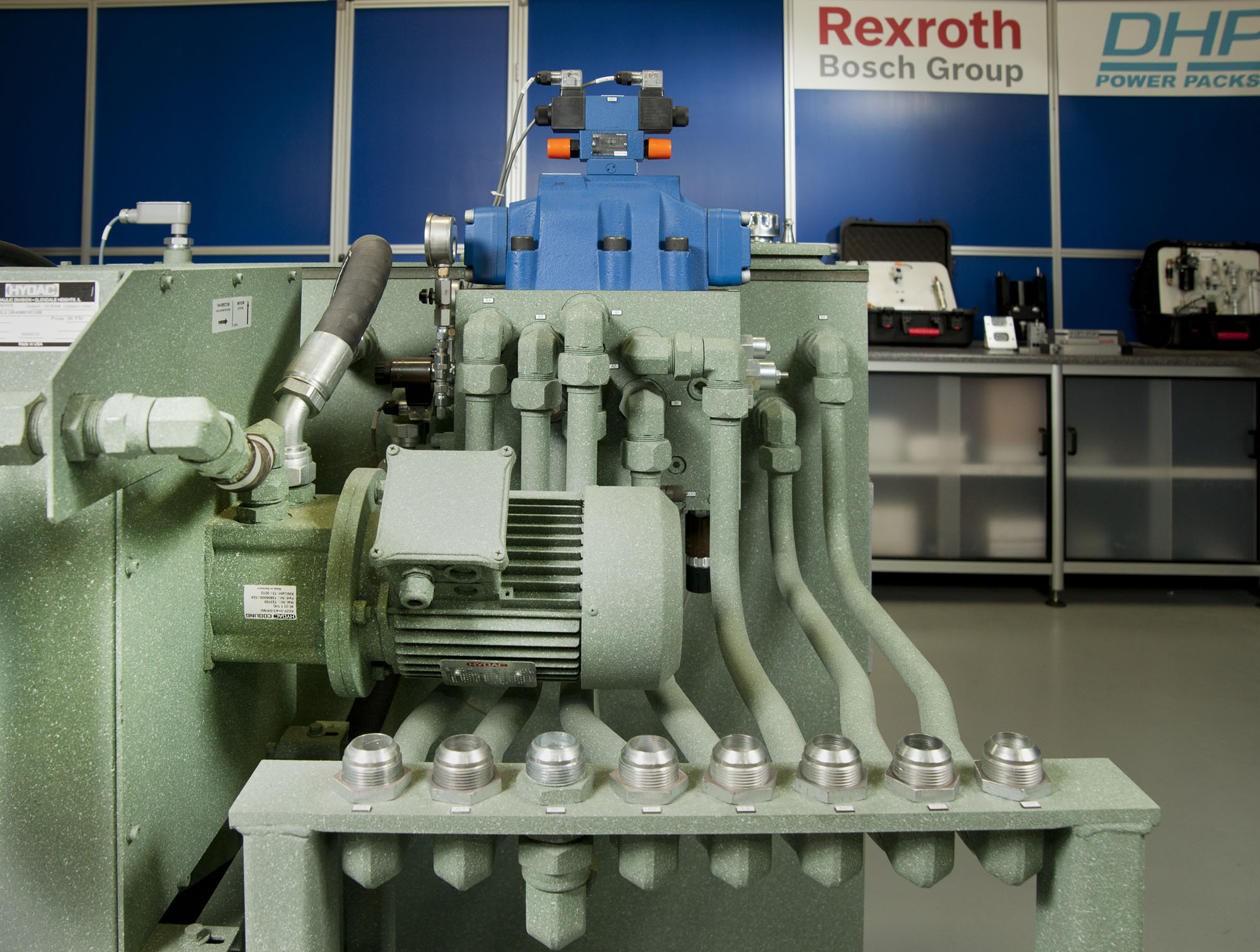 certifications or special environmental coatings. Ambient temperatures may necessitate that enhanced heating or cooling characteristics be applied to the design. Other application-specific nuances or requirements may also influence the ability to utilize configurable or pre-engineered units. Specific real-estate requirements, location, or electrical or plumbing connectivity within the serial machine’s design or frame size may dictate that the unit be a custom solution. Proximity of the power unit to the end-work being accomplished, and length of pipe or tubing runs, may affect the reservoir size and thus tip the scale in favor of custom units. Press applications are an example, where the power unit may reside in a pit controlling actuators multiple stories above the “pit”, or located within a central area, supplying several consumers in a “ring” design. A spatial arrangement such as this may quickly eliminate the ability to use pre-engineered or configurable units. Conversely, smaller clamping units, or ancillary requirements for existing plant-floor installed capital equipment, may be opportunities for pre-engineered units. While perhaps not always considered to be an “environmental” factor, there may be “preferred” construction guidelines or a plant “spec” which dictate the type of power unit chosen. Automotive company specifications are common, as are specs from many other multi-location manufacturers who want to ensure manufacturing system consistency from plant to plant, regardless of location. Specs of this nature often regulate the types and variations of power units used in those facilities. Other plant-specific considerations may be things such as lock-out-tag-out mandates, or safety or risk considerations, which may all force the designer toward custom designs vs. pre-engineered. If the power unit is to be located in an environment with low risk or in which safety risks are reduced, the designer may be able to take advantage of the fast delivery of standard or pre-engineered power unit designs.
certifications or special environmental coatings. Ambient temperatures may necessitate that enhanced heating or cooling characteristics be applied to the design. Other application-specific nuances or requirements may also influence the ability to utilize configurable or pre-engineered units. Specific real-estate requirements, location, or electrical or plumbing connectivity within the serial machine’s design or frame size may dictate that the unit be a custom solution. Proximity of the power unit to the end-work being accomplished, and length of pipe or tubing runs, may affect the reservoir size and thus tip the scale in favor of custom units. Press applications are an example, where the power unit may reside in a pit controlling actuators multiple stories above the “pit”, or located within a central area, supplying several consumers in a “ring” design. A spatial arrangement such as this may quickly eliminate the ability to use pre-engineered or configurable units. Conversely, smaller clamping units, or ancillary requirements for existing plant-floor installed capital equipment, may be opportunities for pre-engineered units. While perhaps not always considered to be an “environmental” factor, there may be “preferred” construction guidelines or a plant “spec” which dictate the type of power unit chosen. Automotive company specifications are common, as are specs from many other multi-location manufacturers who want to ensure manufacturing system consistency from plant to plant, regardless of location. Specs of this nature often regulate the types and variations of power units used in those facilities. Other plant-specific considerations may be things such as lock-out-tag-out mandates, or safety or risk considerations, which may all force the designer toward custom designs vs. pre-engineered. If the power unit is to be located in an environment with low risk or in which safety risks are reduced, the designer may be able to take advantage of the fast delivery of standard or pre-engineered power unit designs.
3. Serviceability / Service Life Even
the most robust power unit design will require service. The power unit designer may or may not be able to influence maintenance practices, or adherence to preventive maintenance schedules. However, in time, components will need to be replaced. Consumables such as filter elements need to be placed in locations that are easy to access, and as the flow rate demands grow, the designer must also consider the size of the filtration canisters with respect to ease of handling. Even components that may be replaced only infrequently or rarely should be considered. A failed 200HP electric motor will need accessibility, and likely a gantry crane to accommodate removal and replacement. Additionally, good practices in power unit design can enhance service life substantially too, for example, making sure that piping, tubing, hoses have correct and proper bend radiuses, and are properly clamped or secured. It’s surprising how often a power unit’s service life is curtailed because of oversights like this. Standard and pre-engineered units have an advantage in this regard because they are designed utilizing good construction practice; however, post power unit connections and terminations also need to carry this proper design methodology throughout the installation. Improper field installation practices can undermine a properly design pre-engineered or custom designed unit. As these units may be in service for decades, poor practices can haunt designers, maintenance crews and plant managers for years to come! The application, of course, will also dictate robustness of component and fluid conveyance products, since specification requirements for a system operating at around 1500psi will certainly differ from those operating at 5000psi or more. With respect to service life, shock could be a significant factor affecting the life and maintenance requirements of a power unit. The designer may or may not have influence on the complete circuit, or the methodology utilized to achieve a desired function, but controlling shock (eg: decompression, acceleration, deceleration, directional changes and so on), will enhance the service life of a power unit significantly.
4. Noise
Manufacturers of pre-engineered or configurable power units may incorporate noise data within their literature. Often these values will be 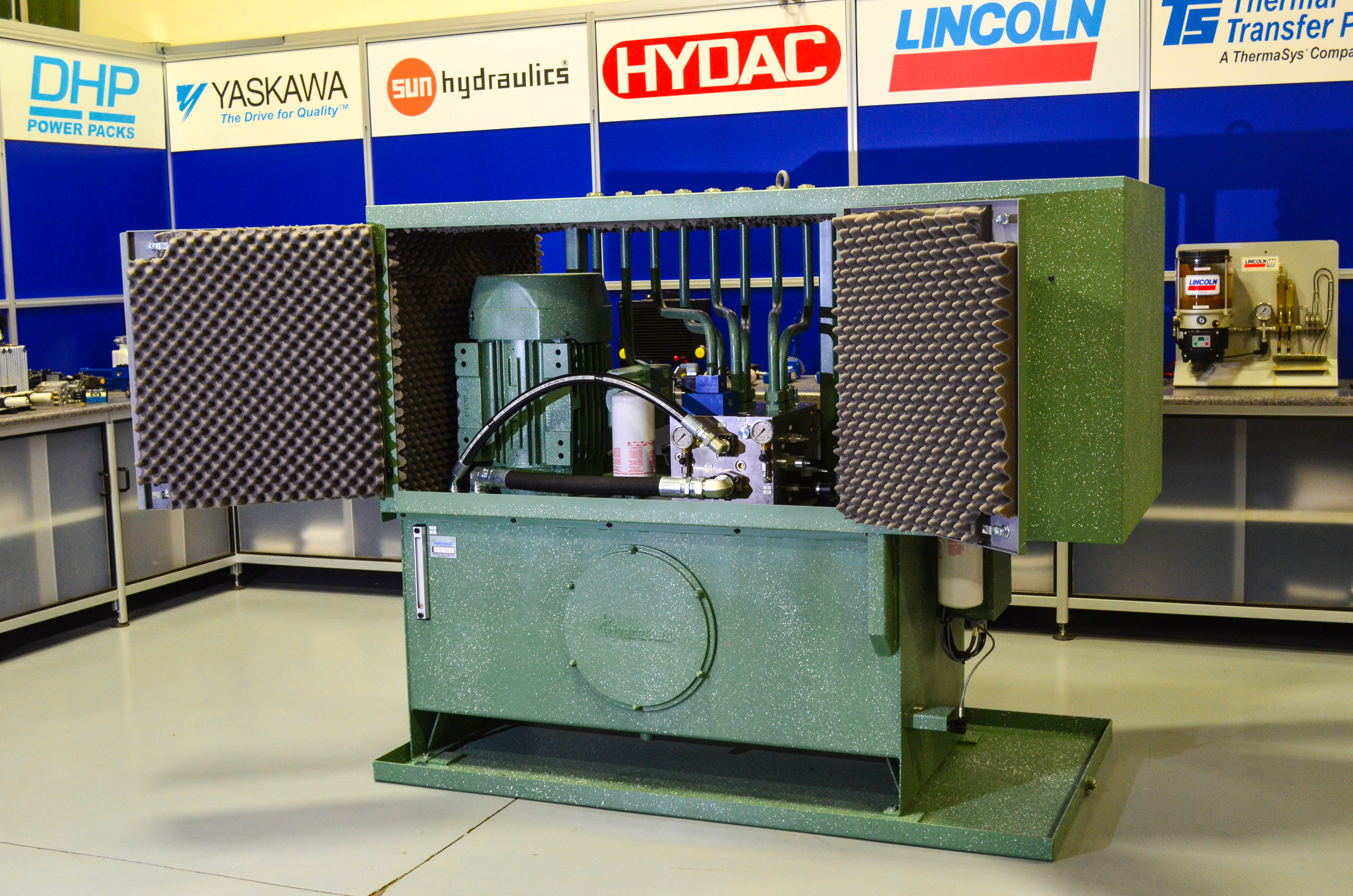 recorded under specific conditions – which may also be defined within that literature – to serve in benchmarking vendors. In many applications regulatory organizations define the permitted noise levels in a confined area or on the plant-floor. Power units not achieving noise statutes may require Personal Protective Devices for personnel performing maintenance or working in proximity of the power unit. Pre-engineered power units may be an attractive solution in these cases, since a manufacturer which can provide this data in published literature typically has the confidence and credibility to perform those tests. It’s also a sign of robust engineering depth within those companies. Of course, with custom units, it’s much more difficult to predict noise data, because the eventual operating environment and other factors may affect noise emission prior to construction (or installation). If noise is a concern, the designer should review the available, published data for selected components which may have the greatest influence on noise, e.g.: the pump & motor assembly and mounting conditions. Whether custom or pre-engineered, however, the designer still needs to consider the circumstances surrounding the installation. A poorly installed unit may produce results counter to the noise expectations as derived from manufacturer data.
recorded under specific conditions – which may also be defined within that literature – to serve in benchmarking vendors. In many applications regulatory organizations define the permitted noise levels in a confined area or on the plant-floor. Power units not achieving noise statutes may require Personal Protective Devices for personnel performing maintenance or working in proximity of the power unit. Pre-engineered power units may be an attractive solution in these cases, since a manufacturer which can provide this data in published literature typically has the confidence and credibility to perform those tests. It’s also a sign of robust engineering depth within those companies. Of course, with custom units, it’s much more difficult to predict noise data, because the eventual operating environment and other factors may affect noise emission prior to construction (or installation). If noise is a concern, the designer should review the available, published data for selected components which may have the greatest influence on noise, e.g.: the pump & motor assembly and mounting conditions. Whether custom or pre-engineered, however, the designer still needs to consider the circumstances surrounding the installation. A poorly installed unit may produce results counter to the noise expectations as derived from manufacturer data.
5. Energy Efficiency
The designer of a power unit may also be directed to consider energy efficiency. While the utilization of high efficiency e-motors could certainly be within this scope, additional considerations toward component selection can also influence consumption and efficiency. Basic fixed displacement pumps that are pressure-limited via a pressure relief valve may be cost effective from a cost-of-components perspective; however, continuous operation at or near e-motor HP ratings may consume energy with little work output being performed. For example, a fixed displacement type power unit may provide the best price-performance ratio for “infrequent-duty” applications, such as a vertical trash baler, which may be used only a few times per day for 10-15 minutes per use. But for applications with simultaneous functions, varying pressure and/or flow requirements per function, or for operations which include dwell times as part of the duty-cycle, variable displacement pumps, frequency converters or servo-driven variable speed drive solutions may provide the most benefit for the money. While the initial cost of components may be greater for a power unit utilizing variable displacement and/or variable speed capability than for a more basic fixed-pump or relief-valve-type power unit, the TCO (Total Cost of Ownership) may be better. The power unit designer may need to consider ancillary devices, such as cooling (air or water, for example) and the costs associated with operating chillers, in the mitigation of heat generated by the more basic fixed-pump or relief valve power units.
6. Cost
Balancing cost vs. robustness and longevity may require innovative solutions which are not pre-engineered or built via a configurator, thereby driving the solution toward customization and uniqueness. As a thread throughout this article, the designer should know that many elements can affect the ultimate performance and long-term cost of a power unit. The purchase price of the components needed to build a power unit is just the starting point – not the only decision criteria. In regard to plant equipment that needs to perform continuously for a long time, potentially in harsh or difficult environments, saving money upfront by using low-cost components may cause maintenance and down-time 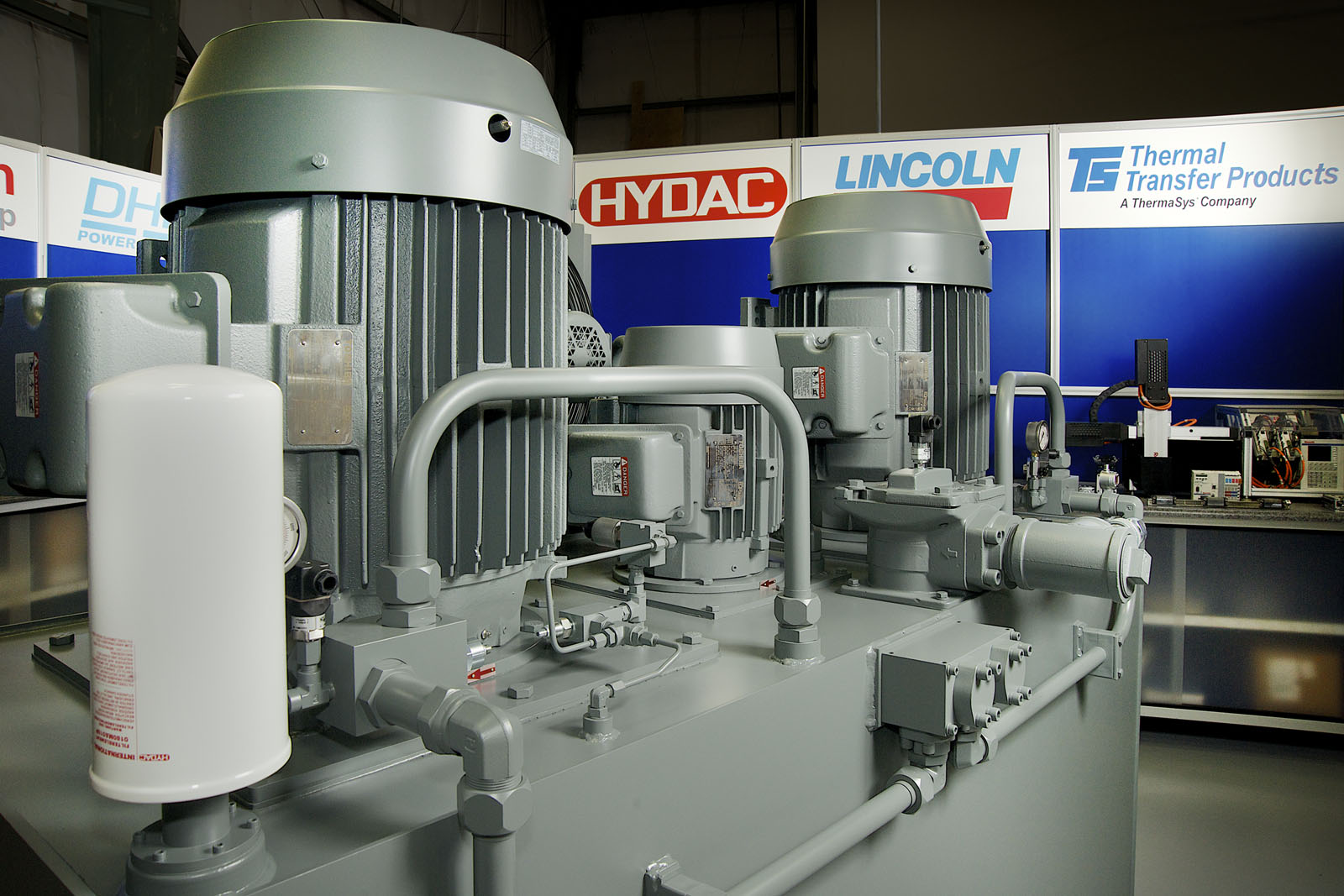 costs far in excess of the initial higher cost of quality components at the outset. High-quality hydraulics may cost more but pay you back quickly via money you didn’t have to spend on unplanned service or downtime. Of course, in considering the cost of a power unit, you need to think about the entire system. Additional cost elements will include the ancillary requirements to support the power unit, such as structure and bracing (a 3,000-gallon reservoir above an aluminum extruder has several more considerations for support than a 300- gallon reservoir resting on the plant floor), location considerations such as elevation, the mounting location (e.g. plant floor, integral to a machine frame, or a central unit), the operating environment, certification and/or safety requirements, and perhaps even physical size. Whether the end A large power unit project like the Panama Canal requires a large team of experts to complete on time. Full-featured, complex hydraulic power units should be designed toward functionality and robustness. A clean design must also consider periodic maintenance and service when needed, for example platforms to contain fluid spills, or easy access for replacement of filters. result is a pre-engineered, serial or a custom one-off solution, calculation to derive a successful power unit requires significant interpretation of, and interaction with, component data, the application’s requirements, and operational and functional requirements far and above the price of the stand-alone components.
costs far in excess of the initial higher cost of quality components at the outset. High-quality hydraulics may cost more but pay you back quickly via money you didn’t have to spend on unplanned service or downtime. Of course, in considering the cost of a power unit, you need to think about the entire system. Additional cost elements will include the ancillary requirements to support the power unit, such as structure and bracing (a 3,000-gallon reservoir above an aluminum extruder has several more considerations for support than a 300- gallon reservoir resting on the plant floor), location considerations such as elevation, the mounting location (e.g. plant floor, integral to a machine frame, or a central unit), the operating environment, certification and/or safety requirements, and perhaps even physical size. Whether the end A large power unit project like the Panama Canal requires a large team of experts to complete on time. Full-featured, complex hydraulic power units should be designed toward functionality and robustness. A clean design must also consider periodic maintenance and service when needed, for example platforms to contain fluid spills, or easy access for replacement of filters. result is a pre-engineered, serial or a custom one-off solution, calculation to derive a successful power unit requires significant interpretation of, and interaction with, component data, the application’s requirements, and operational and functional requirements far and above the price of the stand-alone components.
7. So What About Industry 4.0 and “The Internet of Things?”
Phenomena such as “The Internet of Things”, (IoT), or Industry 4.0, are not precluded from the realm of power units. Today’s designers need also consider connected processes, products, systems, and the additional value that connectivity can bring, whether toward their business or their customers’ business. Hybrid solutions such as variable speed drives with either a frequency converter or with full-fledged servo-driven electrohydraulic pumps are becoming more widely used—often to reduce noise or to lower power consumption. However, these systems may also be able to gather data and send it back through “IoT gateways” as a means toward data analysis or performance monitoring systems. The enhanced communications between plant level networks and plant-floor components thanks to connected power units enable predictive maintenance, as well as real-time diagnostics and system analysis. The result? Reduced ownership costs and increased power unit life. The good news is that the latest IoT or connected technologies are scalable throughout the power unit range, whether standard, pre-engineered or custom. And as IoT and hybrid designs become more often the chosen solution, new products will continue to be developed in response to these evolving demands. Conclusion In truth, with all of the choices facing an engineer designing or selecting a power unit, the fact is this: Designing a power unit can be daunting. Not only must the successful designer develop a robust solution, one that will be capable of producing the “power” required over a long service-life, he or she must also consider plant-floor environments, safety, regulatory requirements, serviceability and maintenance, noise, energy efficiency, and sometimes even IoT-readiness. All of these considerations can influence the lifetime cost. With all of these facets to consider in the design of a power unit, there is an important final consideration: Your power unit supplier. Naturally, you’ll want to find a trusted partner with experience in a broad range of power unit solutions. Additionally, with today’s increasing movement of machines around the world, the possibility that the final machine or product may be exported is greater than ever. Therefore, you’ll need to consider a partner who can provide support wherever your power unit might end up in operation and who is familiar with the safety requirements in the country of operation. If you elect to rely on a premium supplier, compare warranty terms to make sure that you understand any limitations on operational hours, commissioning, geographical location and even availability of service personnel at the final destination. Some suppliers, like Bosch Rexroth, even offer extended warranties if Rexroth filter elements are used. And, of course, make sure to ask about experience, and try to find a partner who has been building high quality, long service-life power units for decades, for both industrial and mobile machinery applications, from fractional HP to systems with 100s of installed HP. If you or your customers have specific certification requirements, such as marine and offshore deployments, check whether your supplier has experience with those, too. In the end, a trusted supplier can make the process of designing or specifying a hydraulic power unit substantially less daunting – and make sure that you’re getting the right system for your exact needs.
Want to learn more? Contact our engineering team today to start your system design!